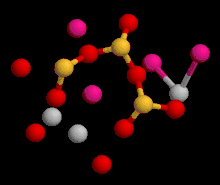Tobermorite
| Tobermorite | |
|---|---|
 Crystalline mass of tobermorite | |
| General | |
| Category |
Silicate mineral, Calcium silicate hydrate |
| Formula (repeating unit) |
Ca5Si6O16(OH)2·4H2O, or; Ca5Si6(O,OH)18·5H2O |
| Strunz classification | 9.DG.10 |
| Crystal system | Orthorhombic |
| Crystal class |
Disphenoidal (222) H-M symbol: (2 2 2) |
| Unit cell |
a = 11.17 Å, b = 7.38 Å c = 22.94 Å; β = 90°; Z = 4 |
| Identification | |
| Formula mass | 702.36 g/mol |
| Color | Pale pinkish white, white, brown |
| Crystal habit | As minute laths; fibrous bundles, rosettes or sheaves, radiating or plumose, fine granular, massive. |
| Cleavage | {001} Perfect, {100} Imperfect |
| Mohs scale hardness | 2.5 |
| Luster | Vitreous, silky in fibrous aggregates |
| Streak | White |
| Diaphaneity | Translucent to translucent |
| Specific gravity | 2.423 - 2.458 |
| Optical properties | Biaxial (+) |
| Refractive index | nα = 1.570 nβ = 1.571 nγ = 1.575 |
| Birefringence | δ = 0.005 |
| Ultraviolet fluorescence | Fluorescent, Short UV:weak white to yellow, Long UV:weak white to yellow |
| References | [1][2][3] |
- Not to be confused with torbernite, a hydrated copper uranyl phosphate.
Tobermorite is a calcium silicate hydrate mineral with chemical formula: Ca5Si6O16(OH)2·4H2O or Ca5Si6(O,OH)18·5H2O.
Two structural varieties are distinguished: tobermorite-11 Å and tobermorite-14 Å. Tobermorite occurs in hydrated cement paste and can be found in nature as alteration mineral in metamorphosed limestone and in skarn. It has been reported from the Maqarin Area of north Jordan and in the Crestmore Quarry near Crestmore Heights, Riverside County, California.
Tobermorite was first described in 1880 for an occurrence in Scotland, on the Isle of Mull, around the locality of Tobermory.[2]
Use in Roman concrete
Aluminium substituted tobermorite is understood to be a key ingredient in the longevity of ancient undersea Roman concrete. The volcanic ash that Romans used for construction of sea walls contained phillipsite, and that an interaction with sea water actually caused the crystalline structures in the mortar to expand and strengthen, making that material substantially more durable than modern concrete when exposed to sea water. [4] [5][6]

Cement chemistry
Tobermorite is often used in thermodynamical calculations to represent the pole of the most evolved calcium silicate hydrate (C-S-H). The value of its Ca/Si or CaO/SiO2 (C/S) ratio is 0.83 (5/6). Jennite represents the less evolved pole with a C/S ratio of 1.5 (9/6).
See also
- Other calcium silicate hydrate (C-S-H) minerals:
References
- ↑ Handbook of Mineralogy
- 1 2 Mindat.org
- ↑ Webmineral data
- ↑ Ancient Romans made world’s ‘most durable’ concrete. We might use it to stop rising seas, Washington Post, Ben Guarino, July 4, 2017. Retrieved July 5, 2017.
- ↑ Ancient lessons: Roman concrete durable, green, Jim Destefani, ed., Ceramic Tech Today, The American Ceramic Society, June 7, 2013
- ↑ Jackson, Marie D.; Mulcahy, Sean R.; Chen, Heng; Li, Yao; Li, Qinfei; Cappelletti, Piergiulio; Wenk, Hans-Rudolf (2017). "Phillipsite and Al-tobermorite mineral cements produced through low-temperature water-rock reactions in Roman marine concrete". American Mineralogist. 102 (7): 1435–1450. doi:10.2138/am-2017-5993CCBY. ISSN 0003-004X.
- American Mineralogist (1954) 39, 1038.
- Abdul-Jaber, Q.H.; Khoury, H. (1998), "Unusual mineralisation in the Maqarin Area (North Jordan) and the occurrence of some rare minerals in the marbles and the weathered rocks", Neues Jahrb. Geol. Paläontol. Abh., 208, pp. 603–629
|access-date=requires|url=(help) - Chen, Jeffrey J.; Jeffrey J. Thomas; Hal F.W. Taylor; Hamlin M. Jennings (2004). "Solubility and structure of calcium silicate hydrate". Cement and Concrete Research. 34 (9): 1499–1519. doi:10.1016/j.cemconres.2004.04.034. ISSN 0008-8846. Retrieved 2009-02-04.
- Coleman, Nichola J. (2011). "11 Ä tobermorite ion exchanger from recycled container glass". International Journal of Environment and Waste Management. 8 (3–4): 366–382. doi:10.1504/IJEWM.2011.042642.
- Currie, J. (1905). "Note on some new localities for gyrolite and tobermorite". Mineralogical Magazine. 14: 93–95. doi:10.1180/minmag.1905.014.64.06.
- Eakle, Arthur S. (1927). "Famous mineral localities: Crestmore, Riverside County, California". American Mineralogist. 12: 319–321. Retrieved 2009-11-01.
- Kikuma, J.; Tsunashima M.; Ishikawa T.; Matsuno S.; Ogawa A.; Matsui K.; Sato M. (2009). "Hydrothermal formation of tobermorite studied by in situ X-ray diffraction under autoclave condition". Journal of Synchrotron Radiation. 16: 683–686. doi:10.1107/s0909049509022080.
- McConnell, J.D.C. (1954). "The hydrated calcium silicates riversideite, tobermorite and plombierite". Mineralogical Magazine. 30: 293–305. doi:10.1180/minmag.1954.030.224.02.
- Merlino, S.; Bonaccorsi E.; Armbruster T. (1999). "Tobermorites: Their real structure and order-disorder (OD) character, Sample: 9 Angstrom". American Mineralogist. 84: 1613–1621.
- Merlino, S.; Bonaccorsi E.; Armbruster T. (2001). "The real structure of tobermorite 11A: normal and anomalous forms, OD character and polytypic modifications (Note: MDO2 - synchrotron radiation source. Locality: Bascenov, Urals, Russia)". European Journal of Mineralogy. 13: 577–590. doi:10.1127/0935-1221/2001/0013-0577.
- Naomichi, Hara (2000). "Formation of jennite and tobermorite from amorphous silica". J. Soc. Inorg. Mater. Japan. 7 (285): 133–142. ISSN 1345-3769. Retrieved 2009-02-04.
External links
| Wikimedia Commons has media related to Crestmore Quarries. |